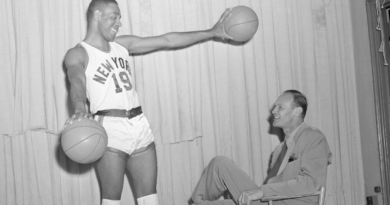The two tricks behind Inter Milan's remarkable season
You either succeed by doing what everybody else does and doing it better than them, or you succeed by doing things differently. The old mantra applies to Inter Milan — who, for all their foibles and weaknesses, are fourth in Serie A, Coppa Italia finalists and holding a commanding 2-0 lead after the first leg of their Champions League semifinal against AC Milan — in two key ways. One of them is “old school” and the other decidedly new school.
The “throwback” point of difference with Inter is the fact that Simone Inzaghi’s side play with two strikers rather than one. The innovation is the way they’ve exploited the rule change from three substitutions to five, effectively “programming” their changes ahead of time and making the same moves, in the same positions, and often at roughly the same point in the match.
– Stream on ESPN+: LaLiga, Bundesliga, more (U.S.)
Attacking tandems were commonplace in European football for many years, but today they are somewhat passe, at least among elite clubs: only a handful of others, such as Atletico Madrid and Leipzig, still use two centre-forwards like Inter. It’s easy to get stuck into semantics here given that formations are fluid, but most top clubs tend to prefer attacking with a central striker and two wide men high up the pitch. Sometimes, they use inverted wingers (e.g., a right-footer down the left) whose runs are designed to take them inside and into the area rather than crossing the ball. Real Madrid‘s Vinicius Junior — a right-footer playing down the left flank — is a prime example of this.
Not Inter. They have four forwards — Lautaro Martinez, Romelu Lukaku, Joaquin Correa, Edin Dzeko — and their schemes are designed around their interplay, with width coming from their wing-backs. Having two guys through the middle — especially against sides that play with four defenders, aka most teams — means you can tie up both central defenders and open space for a runner from midfield.
Inter’s second goal against Milan in Wednesday’s semifinal is a prime example of this: Dzeko and Martinez made runs (one wide, one short) to drag their markers, Fikayo Tomori and Simon Kjaer, out of position, which allowed Henrikh Mkhitaryan to come in from midfield, attack the space and score. (Admittedly Sandro Tonali could have done a better job at tracking Mkhitaryan’s run, but hey: it’s a low-scoring sport in which small details can have outsized effects, and you have to be ready to exploit these errors.)
Most teams, whether they play a back three or back four, simply aren’t accustomed to facing a front two. And that means having to adjust. It’s not rocket science; it’s doable, but in a game of fine margins like a Champions League semifinal, any prep time spent adjusting is time you’re not spending doing something else to help you win. It ends up being one more thing to think about.
1:03
Why AC Milan’s plan backfired against Inter
Gab Marcotti explains what he thinks backfired for AC Milan in their 2-0 defeat to Inter Milan.
There’s another wrinkle in Inter’s case: their four strikers are all substantially different from each other. Lukaku is tall, powerful and direct. Dzeko is also tall, but he’s more wiry, slower (which you expect given that he’s 37 years old) and a gifted passer. Lautaro is smaller, quicker and a gifted dribbler. Correa is sort of a wild card: he’s a bigger guy with “little man” ball control and he offers a healthy dose of unpredictability. This diverse quartet enables Inzaghi to mix and match combinations depending on the opponent and the situation in the game.
Inter have played 49 games this season and the starts have been shared by the foursome: Lautaro has the most (39), followed by Dzeko (30), Lukaku (17) and Correa (14). They’re not quite interchangeable — Lautaro plays more because, well, he’s probably the best of the bunch and Lukaku missed a chunk of the season because of injury — but it’s evident Inzaghi trusts all four. This is borne out in his use of substitutions, his other unique selling point, and the way he has allocated minutes.
Inter have played 34 league games, which means the maximum number of subs they could make is 170; they’ve made 167. Manchester City, by contrast, have also played 34 games, but they have made just 110. There’s no right or wrong here: it’s just a different approach based on what suits your team. But what’s interesting here is that Inter tend to always make the same substitutions. Inzaghi will often replace his two forwards and his two wing-backs — here too there is a fair amount of rotation, with Federico Dimarco and Robin Gosens on the left and Denzel Dumfries and Raoul Bellanova or Matteo Darmian, when he’s not playing centre-back, on the right — usually around the hour mark.
The benefits here are evident. Opposing defenders have to face fresh legs and strikers with different characteristics in the final half-hour. Wing-back in Inzaghi’s 3-5-2 formation is probably the most physically demanding position and obviously, going all-out for 60 minutes is less taxing than doing so for 90 minutes. Inter aren’t a high-paced pressing team, but it’s a fair bet they’d press even less if their forwards had to play a full 90 minutes.
The load management also keeps players motivated: you may start on the bench, but if you’re a wing-back or forward, you know you’ll probably come on and play: Inter’s forwards have come on in more than 85% of the games in which they are benched, while for wing-backs, it’s 78% of the time. And, of course, it helps keep players fresh — especially important in the case of older guys — while minimizing the risk of injury. (Basically: if you’re on the bench, you probably won’t get hurt.)
1:50
Hislop: AC Milan ‘a shadow of themselves’ in disappointing defeat
Shaka Hislop says AC Milan’s missed chances may come back to haunt them in the second leg against Inter.
Obviously, before we hail Inzaghi as a genius and innovator, there are some caveats. This approach only works when you’ve got guys of comparable ability, like Dzeko and Lukaku (or, at least, this season’s version of Lukaku). If Carlo Ancelotti started alternating Karim Benzema and Mariano Diaz at Real Madrid, or if Arsenal‘s Mikel Arteta took off Bukayo Saka for Reiss Nelson after 60 minutes in every game, they’d probably be arrested for crimes against football. Also, what you gain in freshness and unpredictability, you lose in terms of chemistry: the more you play together, the better you understand each other. It’s no coincidence that when it comes to midfield and central defence, Inzaghi tends not to do this because chemistry and coordination matters more in those roles.
However, his approach is working a charm for Inter this season. It has enabled them to navigate some rough moments and keep the players happy — no easy task at a club that, historically, has been the epitome of chaos and instability. It also raises the question of how much more coaches can do with the luxury of five substitutions and how they might change the game. The sense is that, with the exception of Inzaghi and a few others, most have barely scratched the surface.
All in all, Inter’s successes show that being different can sometimes be just as important as being good.




